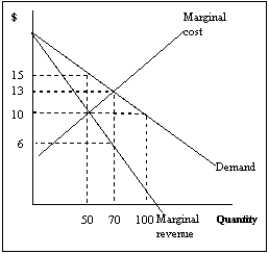B) False
Correct Answer

verified
Correct Answer
verified
True/False
For a monopoly,average revenue is always less than price.
B) False
Correct Answer

verified
Correct Answer
verified
Multiple Choice
The demand curve facing a monopoly firm
A) may well bend backward.
B) suggests that the monopoly can sell additional units without lowering the price.
C) is the market demand curve.
D) is equal to its total revenue curve.
E) is perfectly inelastic.
G) A) and C)
Correct Answer

verified
Correct Answer
verified
Multiple Choice
For a natural monopoly,the minimum efficient scale is
A) sometimes smaller and sometimes larger than the size of the market.
B) larger than the size of the market.
C) smaller than the size of the market.
D) equal to the size of the market.
E) zero.
G) B) and D)
Correct Answer

verified
Correct Answer
verified
Multiple Choice
Suppose a firm decides to cut its production in half.One could claim that this firm has market power if there is a significant change in the
A) firm's total cost.
B) market price of the product.
C) firm's total revenue.
D) firm's marginal revenue.
E) firm's average revenue.
G) A) and D)
Correct Answer

verified
Correct Answer
verified
True/False
Marginal revenue and demand are unrelated.
B) False
Correct Answer

verified
Correct Answer
verified
True/False
The profit-maximizing output level is determined on a monopoly diagram by finding the point at which the demand and marginal cost curves cross.
B) False
Correct Answer

verified
Correct Answer
verified
Multiple Choice
Which of the following statements about natural monopolies is not true?
A) Natural monopolies can be eliminated through technological change.
B) Natural monopolies occur because of the nature of the market system.
C) Cost-curve characteristics are one reason natural monopolies occur.
D) Natural monopolies occur when minimum efficient scale is reached after demand is satisfied.
E) The average total costs of natural monopolies continue to decline over production.
G) All of the above
Correct Answer

verified
Correct Answer
verified
True/False
Government licensing policies can eliminate monopolies.
B) False
Correct Answer

verified
Correct Answer
verified
True/False
For a monopoly to maximize profits,price must exceed marginal cost.
B) False
Correct Answer

verified
Correct Answer
verified
Multiple Choice
Exhibit 10-5  -Refer to Exhibit 10-5 for a profit-maximizing monopoly.If the average total cost for the monopoly producing 50 units equals $13,then it will
-Refer to Exhibit 10-5 for a profit-maximizing monopoly.If the average total cost for the monopoly producing 50 units equals $13,then it will
A) make a total economic profit of $5.
B) make a total economic profit of $100.
C) incur a loss of $5.
D) incur a loss of $100.
E) break even.
G) B) and E)
Correct Answer

verified
Correct Answer
verified
True/False
A firm with market power can always sell more by raising the price of its product.
B) False
Correct Answer

verified
Correct Answer
verified
Multiple Choice
Which of the following is not an example of price discrimination?
A) Charging more to send a large package than a small package
B) Airlines charging different amounts based on how early reservations are made
C) Letting children eat free when accompanied by an adult in a nice restaurant
D) Taverns charging cover charges only to men
E) Magazine publishers charging less for student subscriptions than general subscriptions
G) B) and E)
Correct Answer

verified
Correct Answer
verified
Multiple Choice
Which of the following is a characteristic of a monopoly?
A) Free entry
B) Single buyer
C) Price-maker
D) Price-taker
E) Product differentiation
G) C) and D)
Correct Answer

verified
Correct Answer
verified
True/False
A natural monopoly arises when the government creates a legal barrier that prevents firms from entering a market.
B) False
Correct Answer

verified
Correct Answer
verified
Multiple Choice
An example of price discrimination with a quantity discount is
A) Wal-Mart selling for less by moving a large volume of merchandise.
B) charging commercial telephone users higher fees.
C) sightseeing tours.
D) lower long-distance charges the more you use the service.
E) one person buying 100 units of a good and being charged less total shipping than 100 people buying one unit each.
G) A) and D)
Correct Answer

verified
Correct Answer
verified
True/False
A monopoly's demand curve is less elastic than a perfect competitor's demand curve.
B) False
Correct Answer

verified
Correct Answer
verified
Multiple Choice
The deadweight loss from monopoly is the result of
A) marginal cost being upward-sloping.
B) irrational action on the part of consumers.
C) the higher price charged and higher quantity produced compared to competition.
D) the fact that price and marginal revenue are not the same.
E) profit maximization as a motivating factor.
G) B) and E)
Correct Answer

verified
Correct Answer
verified
Multiple Choice
The reason a monopoly produces less than a competitive industry with identical costs is that
A) in a competitive industry there are more firms,which leaves more money available for production.
B) There is not enough information to answer this question.
C) competitive firms' marginal revenue equals marginal cost,so the industry produces at the point at which demand and marginal cost cross instead of the point at which marginal revenue and marginal cost cross.
D) monopolies are usually regulated industries,and the government limits production.
E) production costs are always higher for monopolies than for competitive firms.
G) A) and B)
Correct Answer

verified
Correct Answer
verified
Multiple Choice
The market demand curve that a monopoly faces implies that
A) the law of demand is still at work.
B) cost does not matter.
C) the monopoly can increase price indiscriminately and consumers have no choice but to pay it.
D) the monopoly does not have to be concerned about making profits.
E) an increase in output will not affect price.
G) C) and D)
Correct Answer

verified
Correct Answer
verified
Showing 81 - 100 of 183
Related Exams